Peugeot Partner Tepee 2016 Repair Manual
Manufacturer: PEUGEOT, Model Year: 2016, Model line: Partner Tepee, Model: Peugeot Partner Tepee 2016Pages: 296, PDF Size: 10.76 MB
Page 61 of 296
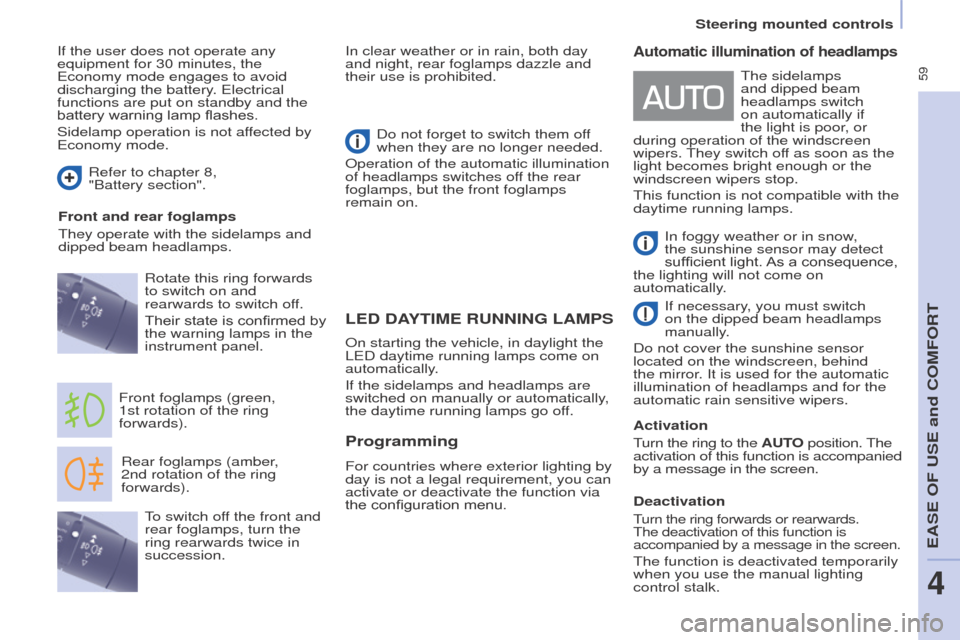
59
LeD DAYtIMe RuNNINg LAMPS
Rear foglamps (amber,
2nd rotation of the ring
forwards).
Front foglamps (green,
1st
rotation of the ring
forwards). Rotate this ring forwards
to switch on and
rearwards to switch off.
Their state is confirmed by
the warning lamps in the
instrument panel. Do not forget to switch them off
when they are no longer needed.
o
peration of the automatic illumination
of headlamps switches off the rear
foglamps, but the front foglamps
remain on.
To switch off the front and
rear foglamps, turn the
ring rearwards twice in
succession.
Automatic illumination of headlamps
In foggy weather or in snow,
the sunshine sensor may detect
sufficient light. As a consequence,
the lighting will not come on
automatically.
If necessary, you must switch
on the dipped beam headlamps
manually.
Do not cover the sunshine sensor
located on the windscreen, behind
the mirror. It is used for the automatic
illumination of headlamps and for the
automatic rain sensitive wipers.
Activation
Turn the ring to the A
uto position. The
activation of this function is accompanied
by a message in the screen.
Deactivation
Turn the ring forwards or rearwards.
The deactivation of this function is
accompanied by a message in the screen.
The function is deactivated temporarily
when you use the manual lighting
control stalk. The sidelamps
and dipped beam
headlamps switch
on automatically if
the light is poor, or
during operation of the windscreen
wipers. They switch off as soon as the
light becomes bright enough or the
windscreen wipers stop.
This function is not compatible with the
daytime running lamps.
o
n starting the vehicle, in daylight the
L
e
D daytime running lamps come on
automatically.
If the sidelamps and headlamps are
switched on manually or automatically,
the daytime running lamps go off.
Programming
For countries where exterior lighting by
day is not a legal requirement, you can
activate or deactivate the function via
the configuration menu.
If the user does not operate any
equipment for 30 minutes, the
e
conomy mode engages to avoid
discharging the battery.
e
lectrical
functions are put on standby and the
battery warning lamp flashes.
Sidelamp operation is not affected by
e
conomy mode.
In clear weather or in rain, both day
and night, rear foglamps dazzle and
their use is prohibited.
Refer to chapter 8,
"Battery
section".
Front and rear foglamps
They operate with the sidelamps and
dipped beam headlamps.
Steering mounted controls
eASe oF uSe and CoMFoRT
4
Page 62 of 296
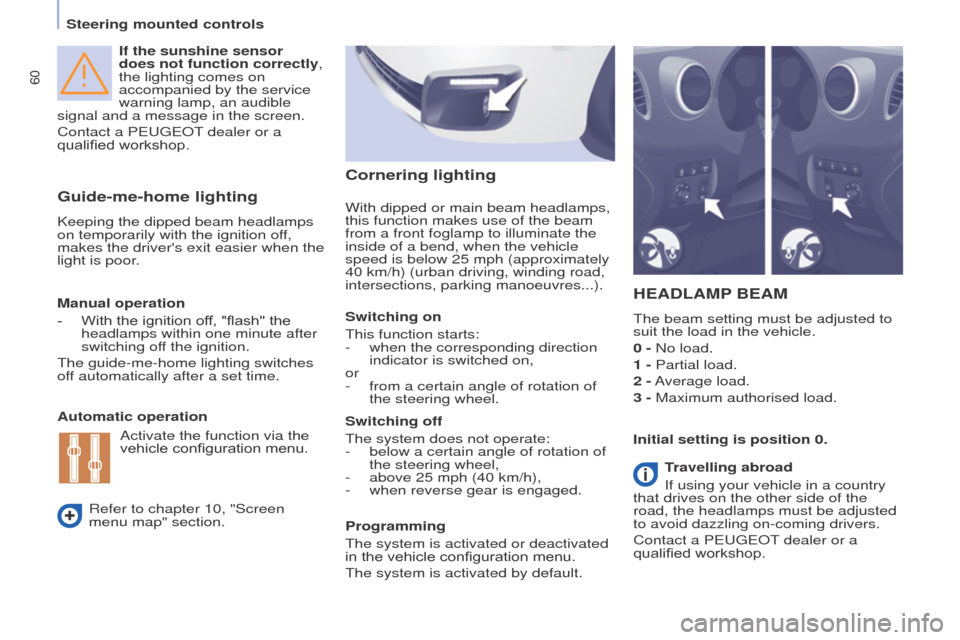
60
If the sunshine sensor
does not function correctly,
the lighting comes on
accompanied by the service
warning lamp, an audible
signal and a message in the screen.
Contact a P
eugeo T dealer or a
qualified workshop.
guide-me-home lighting
Keeping the dipped beam headlamps
on temporarily with the ignition off,
makes the driver's exit easier when the
light is poor.
HeADLAMP B e AM
The beam setting must be adjusted to
suit the load in the vehicle.
0 - No load.
1 - Partial load.
2 - Average load.
3 - Maximum authorised load.
Manual operation
-
With the ignition of
f, "flash" the
headlamps within one minute after
switching off the ignition.
The guide-me-home lighting switches
off automatically after a set time.
Automatic operation
Refer to chapter 10, "Screen
menu map" section. Initial setting is position 0.
Activate the function via the
vehicle configuration menu.
Programming
The system is activated or deactivated
in the vehicle configuration menu.
The system is activated by default. Switching off
The system does not operate:
-
below a certain angle of rotation of
the steering wheel,
-
above 25 mph (40 km/h),
-
when reverse gear is engaged.
Switching on
This function starts:
-
when the corresponding direction
indicator is switched on,
or
-
from a certain angle of rotation of
the steering wheel.
With dipped or main beam headlamps,
this function makes use of the beam
from a front foglamp to illu
minate the
inside of a bend, when the vehicle
speed is below 25 mph (approximately
40 km/h) (urban driving, winding road,
intersections, parking manoeuvres...).
Cornering lighting
travelling abroad
If using your vehicle in a country
that drives on the other side of the
road, the headlamps must be adjusted
to avoid dazzling on-coming drivers.
Contact a P
eugeo T dealer or a
qualified workshop.
Steering mounted controls
Page 63 of 296
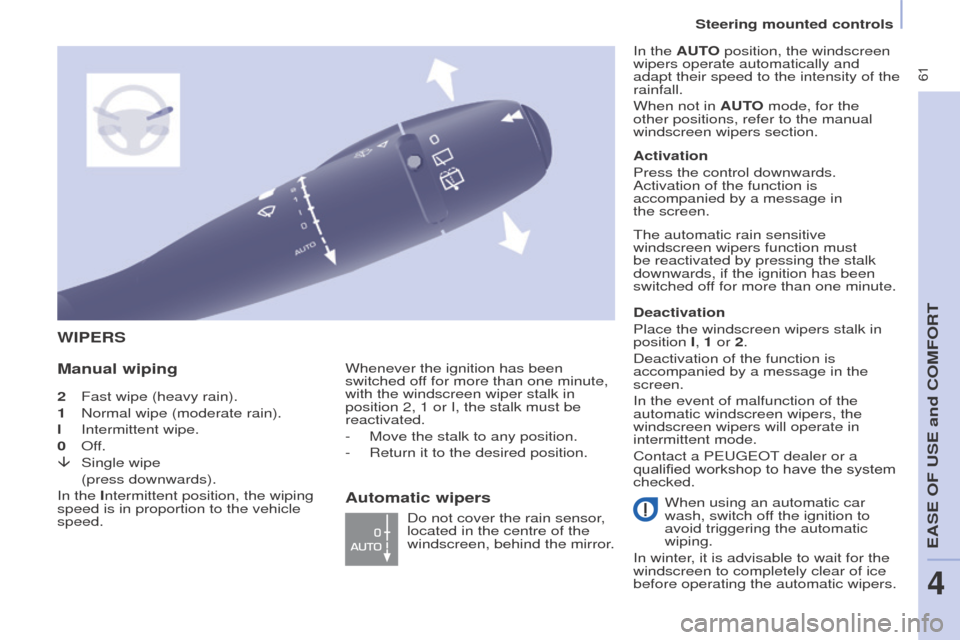
61
2 Fast wipe (heavy rain).
1
Normal wipe (moderate rain).
l
Intermittent wipe.
0
o ff.
â
Single wipe
(press downwards).
In the
Intermittent position, the wiping
speed is in proportion to the vehicle
speed.
WIPeRS
Manual wipingWhenever the ignition has been
switched off for more than one minute,
with the windscreen wiper stalk in
position 2, 1 or I, the stalk must be
reactivated.
-
Move the stalk to any position.
-
Return it to the desired position. Do not cover the rain sensor
,
located in the centre of the
windscreen, behind the mirror. Activation
Press the control downwards.
Activation of the function is
accompanied by a message in
the
screen.
Deactivation
Place the windscreen wipers stalk in
position I, 1 or 2.
Deactivation of the function is
accompanied by a message in the
screen.
In the event of malfunction of the
automatic windscreen wipers, the
windscreen wipers will operate in
intermittent mode.
Contact a P eugeo T dealer or a
qualified workshop to have the system
checked. In the A uto position, the windscreen
wipers operate automatically and
adapt their speed to the intensity of the
rainfall.
When not in A uto mode, for the
other positions, refer to the manual
windscreen wipers section.
The automatic rain sensitive
windscreen wipers function must
be reactivated by pressing the stalk
downwards, if the ignition has been
switched off for more than one minute.
When using an automatic car
wash, switch off the ignition to
avoid triggering the automatic
wiping.
In winter, it is advisable to wait for the
windscreen to completely clear of ice
before operating the automatic wipers.
Automatic wipers
Steering mounted controls
eASe oF uSe and CoMFoRt
4
Page 64 of 296
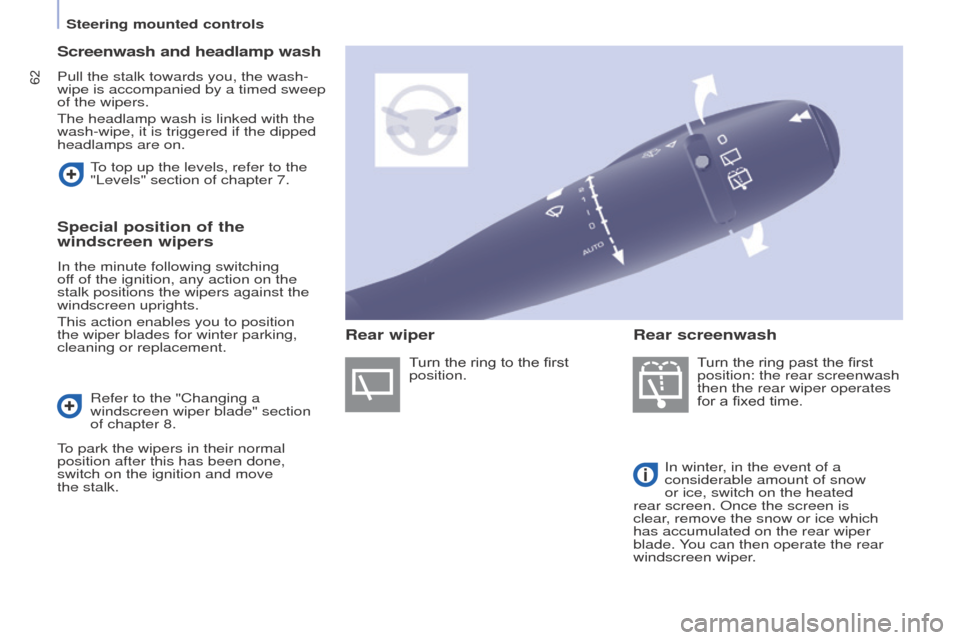
62
Screenwash and headlamp wash
Pull the stalk towards you, the wash-
wipe is accompanied by a timed sweep
of the wipers.
The headlamp wash is linked with the
wash-wipe, it is triggered if the dipped
headlamps are on.Turn the ring past the first
position: the rear screenwash
then the rear wiper operates
for a fixed time.
In winter, in the event of a
considerable amount of snow
or ice, switch on the heated
rear screen.
o nce the screen is
clear, remove the snow or ice which
has accumulated on the rear wiper
blade. You can then operate the rear
windscreen wiper.
To top up the levels, refer to the
"Levels" section of chapter 7.
Special position of the
windscreen wipers
In the minute following switching
off of the ignition, any action on the
stalk positions the wipers against the
windscreen uprights.
This action enables you to position
the wiper blades for winter parking,
cleaning or replacement.
Refer to the "Changing a
windscreen wiper blade" section
of chapter 8.
To park the wipers in their normal
position after this has been done,
switch on the ignition and move
the
stalk. Turn the ring to the first
position.
Rear wiper
Rear screenwash
Steering mounted controls
Page 65 of 296
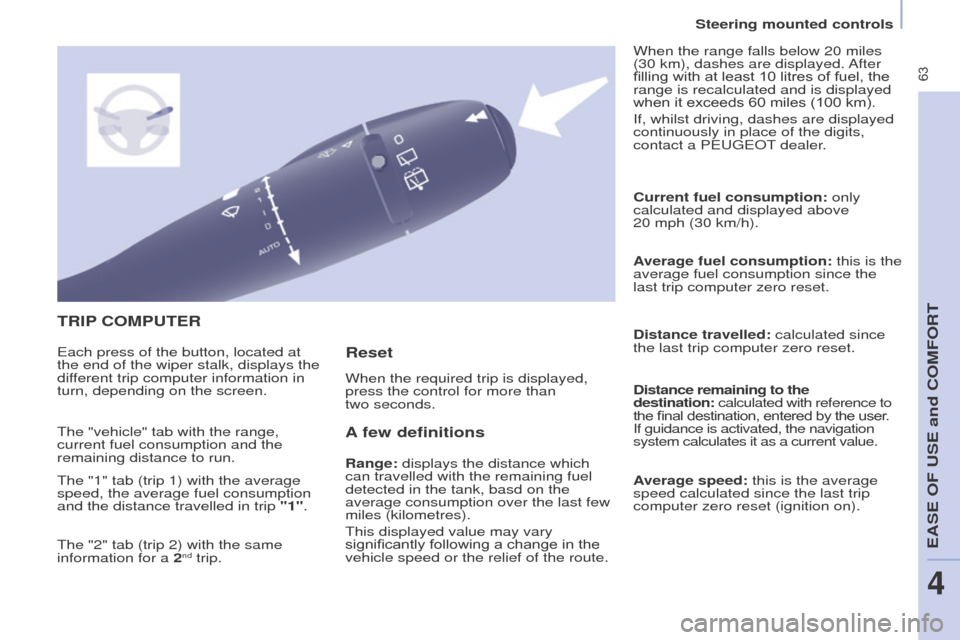
63
tRIP C o MP ute R
A
few definitions
Range: displays the distance which
can travelled with the remaining fuel
detected in the tank, basd on the
average consumption over the last few
miles (kilometres).
This displayed value may vary
significantly following a change in the
vehicle speed or the relief of the route. Current fuel consumption:
only
calculated and displayed above
20 mph (30 km/h).
Average fuel consumption: this is the
average fuel consumption since the
last trip computer zero reset.
Distance travelled: calculated since
the last trip computer zero reset.
Distance remaining to the
destination: calculated with reference to
the final destination, entered by the user.
If guidance is activated, the navigation
system calculates it as a current value.
Average speed: this is the average
speed calculated since the last trip
computer zero reset (ignition on).
e
ach press of the button, located at
the end of the wiper stalk, displays the
different trip computer information in
turn, depending on the screen. When the required trip is displayed,
press the control for more than
two seconds. When the range falls below 20 miles
(30 km), dashes are displayed. After
filling with at least 10 litres of fuel, the
range is recalculated and is displayed
when it exceeds 60 miles (100 km).
If, whilst driving, dashes are displayed
continuously in place of the digits,
contact a P
eugeo T dealer.
The "vehicle" tab with the range,
current fuel consumption and the
remaining distance to run.
The "1" tab (trip 1) with the average
speed, the average fuel consumption
and the distance travelled in trip "1".
The "2" tab (trip 2) with the same
information for a 2
nd trip.
Reset
Steering mounted controls
eASe oF uSe and CoMFoRt
4
Page 66 of 296
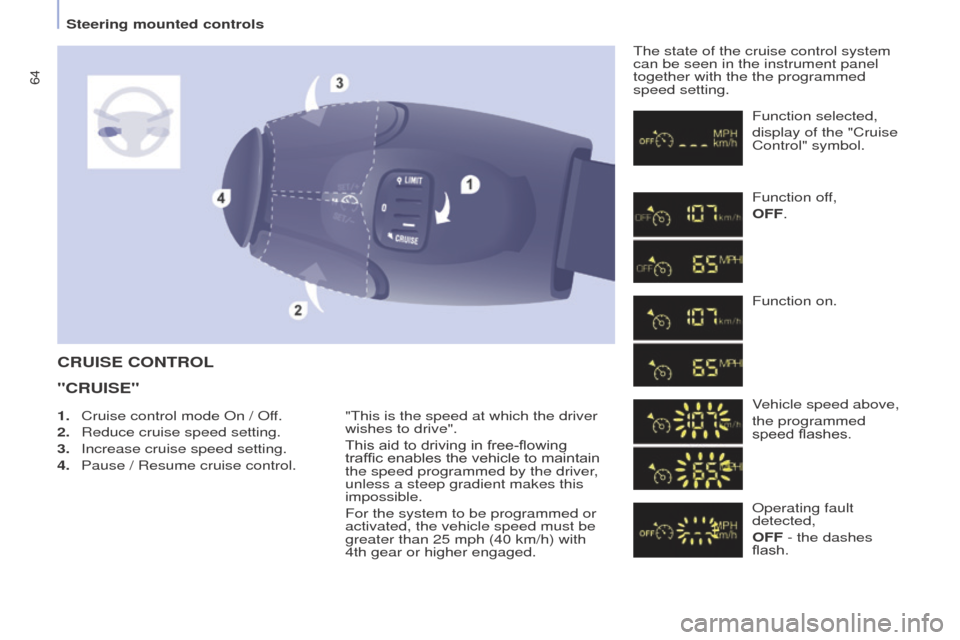
64
CRuISe CoNtRoL
"CR
u IS e "
"This is the speed at which the driver
wishes to drive".
This aid to driving in free-flowing
traffic enables the vehicle to maintain
the speed programmed by the driver,
unless a steep gradient makes this
impossible.
For the system to be programmed or
activated, the vehicle speed must be
greater than 25 mph (40 km/h) with
4th
gear or higher engaged. The state of the cruise control system
can be seen in the instrument panel
together with the the programmed
speed setting.
Function selected,
display of the "Cruise
Control" symbol.
Function off,
o
FF.
Function on.
Vehicle speed above,
the programmed
speed flashes.
o
perating fault
detected,
o
FF - the dashes
flash.
1.
Cruise control mode
o
n /
o
ff.
2.
Reduce cruise speed setting.
3.
Increase cruise speed setting.
4.
Pause / Resume cruise control.
Steering mounted controls
Page 67 of 296
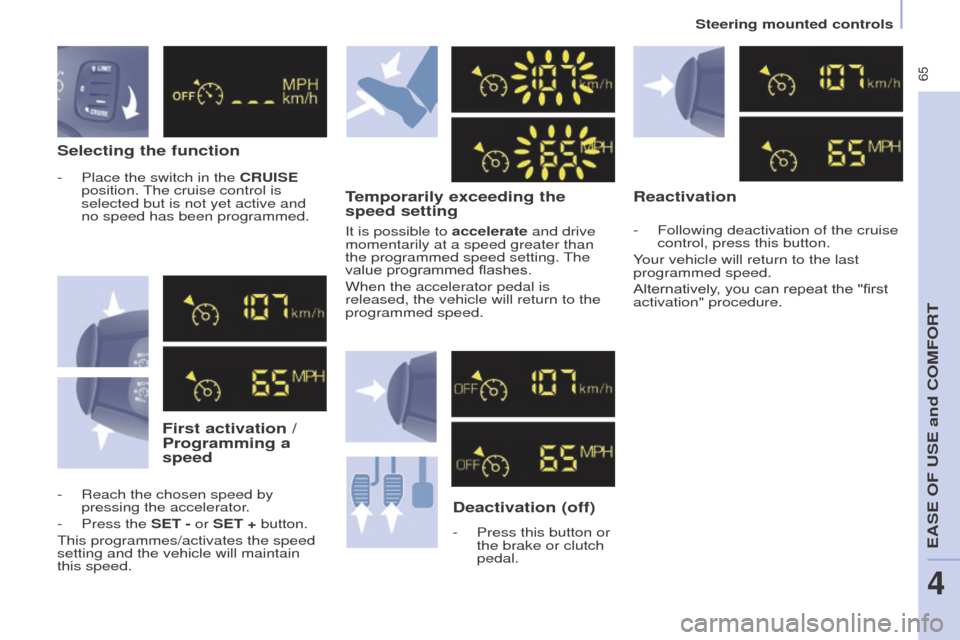
65
Selecting the functionFirst activation /
Programming a
speed
temporarily exceeding the
speed setting
Deactivation (off)
- Press this button or
the brake or clutch
pedal.
Reactivation
- Following deactivation of the cruise
control, press this button.
Y
our vehicle will return to the last
programmed speed.
Alternatively, you can repeat the "first
activation" procedure.
It is possible to accelerate and drive
momentarily at a speed greater than
the programmed speed setting. The
value programmed flashes.
When the accelerator pedal is
released, the vehicle will return to the
programmed speed.
-
Reach the chosen speed by
pressing the accelerator
.
-
Press the
S
et
- or S
et
+ button.
This programmes/activates the speed
setting and the vehicle will maintain
this speed. -
Place the switch in the
CR
u
IS
e
position. The cruise control is
selected but is not yet active and
no speed has been programmed.
Steering mounted controls
eASe oF uSe and CoMFoRt
4
Page 68 of 296
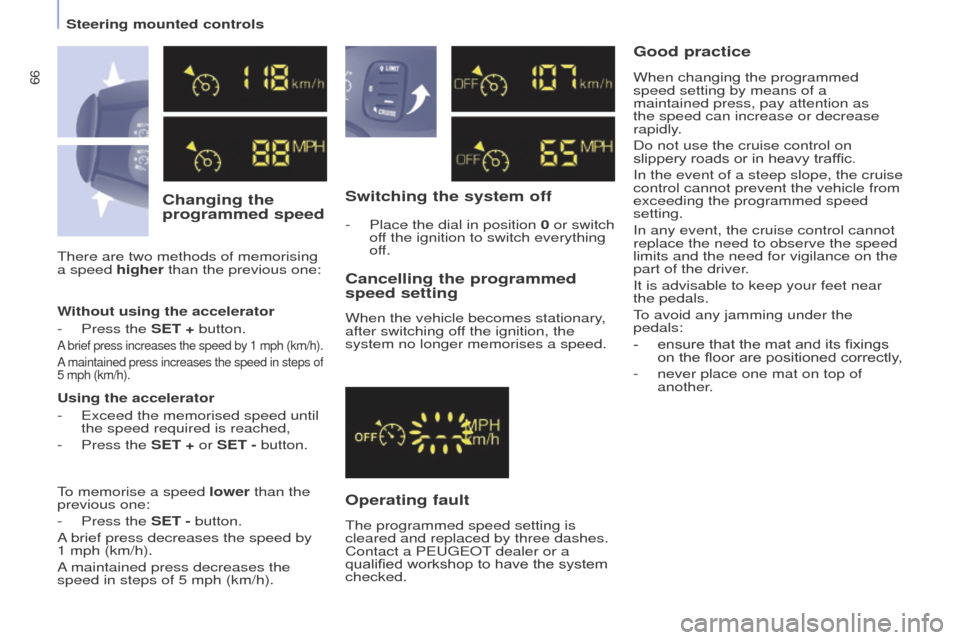
66
Changing the
programmed speedSwitching the system off
o
perating fault
Cancelling the programmed
speed setting
When the vehicle becomes stationary,
after switching off the ignition, the
system no longer memorises a speed.
There are two methods of memorising
a speed higher than the previous one:
-
Place the dial in position
0 or switch
off the ignition to switch everything
off.
good practice
Without using the accelerator
-
Press the
S et + button.
A brief press increases the speed by 1 mph (km/h).
A maintained press increases the speed in steps of
5 mph (km/h).
using the accelerator
- e xceed the memorised speed until
the speed required is reached,
-
Press the
S et + or S et - button.
To memorise a speed lower than the
previous one:
-
Press the
S et - button.
A brief press decreases the speed by
1
mph (km/h).
A maintained press decreases the
speed in steps of 5 mph (km/h). The programmed speed setting is
cleared and replaced by three dashes.
Contact a P
eugeo T dealer or a
qualified workshop to have the system
checked. When changing the programmed
speed setting by means of a
maintained press, pay attention as
the speed can increase or decrease
rapidly.
Do not use the cruise control on
slippery roads or in heavy traffic.
In the event of a steep slope, the cruise
control cannot prevent the vehicle from
exceeding the programmed speed
setting.
In any event, the cruise control cannot
replace the need to observe the speed
limits and the need for vigilance on the
part of the driver.
It is advisable to keep your feet near
the pedals.
To avoid any jamming under the
pedals:
-
ensure that the mat and its fixings
on the floor are positioned correctly
,
-
never place one mat on top of
another
.
Steering mounted controls
Page 69 of 296
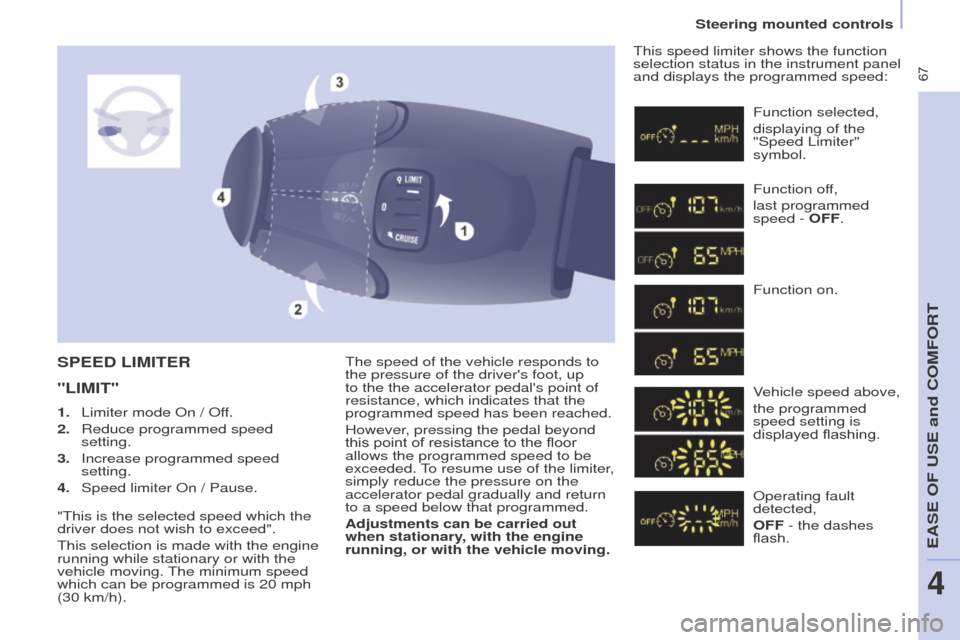
67
The speed of the vehicle responds to
the pressure of the driver's foot, up
to the the accelerator pedal's point of
resistance, which indicates that the
programmed speed has been reached.
However, pressing the pedal beyond
this point of resistance to the floor
allows the programmed speed to be
exceeded. To resume use of the limiter,
simply reduce the pressure on the
accelerator pedal gradually and return
to a speed below that programmed.
Adjustments can be carried out
when stationary, with the engine
running, or with the vehicle moving.This speed limiter shows the function
selection status in the instrument panel
and displays the programmed speed:SPeeD LIMIteR
"LIMI
t "
Function selected,
displaying of the
"Speed Limiter"
symbol.
Function off,
last programmed
speed -
o FF.
Function on.
Vehicle speed above,
the programmed
speed setting is
displayed flashing.
o
perating fault
detected,
o
FF - the dashes
flash.
1.
Limiter mode
o
n /
o
ff.
2.
Reduce programmed speed
setting.
3.
Increase programmed speed
setting.
4.
Speed limiter
o
n / Pause.
"This is the selected speed which the
driver does not wish to exceed".
This selection is made with the engine
running while stationary or with the
vehicle moving. The minimum speed
which can be programmed is 20 mph
(30 km/h).
Steering mounted controls
eASe oF uSe and CoMFoRT
4
Page 70 of 296
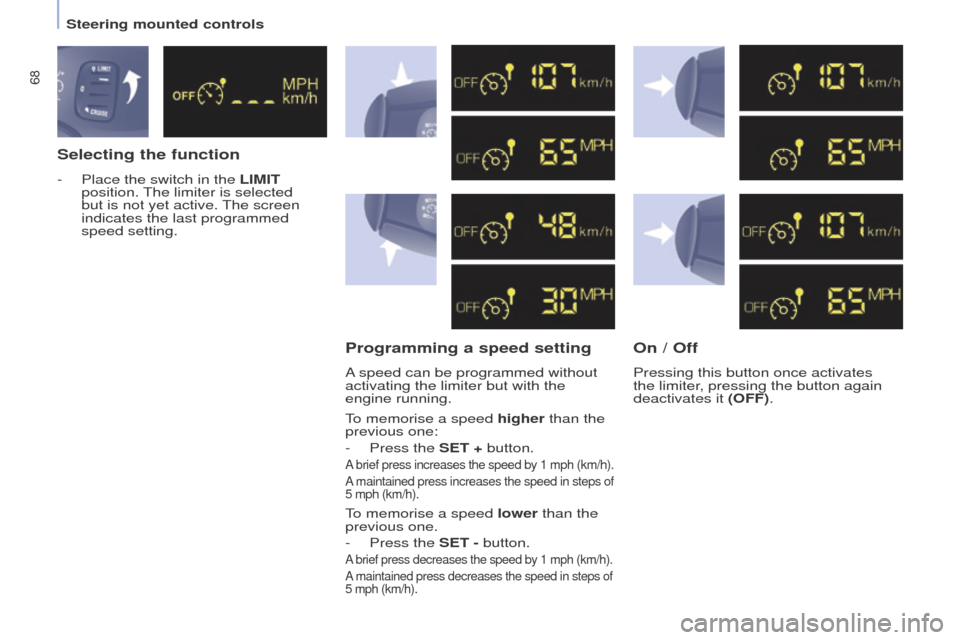
68
Selecting the functionProgramming a speed setting
o
n / o ff
- Place the switch in the LIMI t
position. The limiter is selected
but is not yet active. The screen
indicates the last programmed
speed setting.
A speed can be programmed without
activating the limiter but with the
engine running.
To memorise a speed higher than the
previous one:
-
Press the
S et + button.
A brief press increases the speed by 1 mph (km/h).
A maintained press increases the speed in steps of
5 mph (km/h).
To memorise a speed lower than the
previous one.
-
Press the
S et - button.
A brief press decreases the speed by 1 mph (km/h).
A maintained press decreases the speed in steps of
5 mph (km/h).
Pressing this button once activates
the limiter, pressing the button again
deactivates it (o FF).
Steering mounted controls